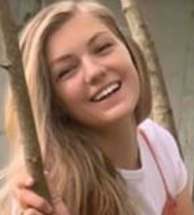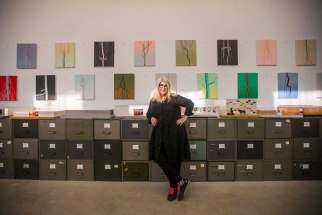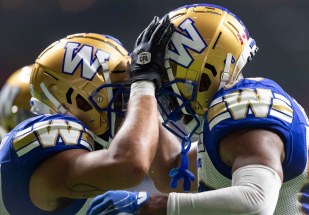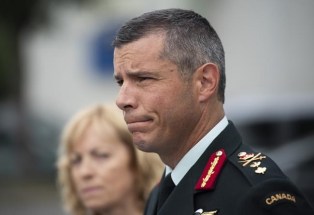Riding proud, from past to future For three decades Sioux Valley Dakota Unity Riders have travelled on horseback to call attention to Indigenous issues and maintain vital connections with their ancestors
Read this article for free:
or
Already have an account? Log in here »
To continue reading, please subscribe:
Monthly Digital Subscription
$1 per week for 24 weeks*
- Enjoy unlimited reading on winnipegfreepress.com
- Read the E-Edition, our digital replica newspaper
- Access News Break, our award-winning app
- Play interactive puzzles
*Billed as $4 plus GST every four weeks. Offer only available to new and qualified returning subscribers. Cancel any time.
Read unlimited articles for free today:
or
Already have an account? Log in here »
Hey there, time traveller!
This article was published 22/10/2021 (1229 days ago), so information in it may no longer be current.
The riders take a break as the sun climbs high, pulling the horses off the road somewhere on the long, flat highway north from Sioux Valley Dakota Nation. They’ve ridden maybe 11 kilometres at this point, riders guiding horses through the long grasses in the ditch, trucks hauling horse trailers purring along beside them.
Although it’s already mid-October, the heat has crept up on them with a surprising conviction, and the horses, some new to being ridden and others getting long in the tooth, need a rest. So the Sioux Valley Dakota Unity Riders decide to break for lunch, to laugh and also to pray.
For three decades, the Unity Riders have made journeys like these, trekking on horseback to call attention to issues that impact Indigenous communities and beyond. Today, they ride for kidney disease awareness. In June, they led a large ride to Brandon in memory of the children lost to residential schools.

Sometimes, they wear traditional regalia; today, they wear hoodies and jeans. Sometimes, dozens of equestrians join the ride; today, there are just five. There were more who wanted to come, but it’s the long weekend and many have plans. Still, the ride is sacred to them, no matter how big or how small, and so it must go on.
Now, the trucks pull onto a dirt road, lined by a few trees and fields of untamed grasses. For the horses, there are buckets of water and handfuls of oats; for the people, there are sandwiches. They sit for a while in the thin ribbon of shade cast by the trailers, chatting quietly as the horses nicker and sigh.
Travis Mazawasicuna stands and gathers the group around him. At 55, his face holds the lines of years spent on the land; he wears a cream cowboy hat and a plaid shirt buttoned over jeans. He holds a bowl of food in one hand, and covers it prayerfully with the other: a spirit dish, in the Dakota way. An offering to the ancestors.
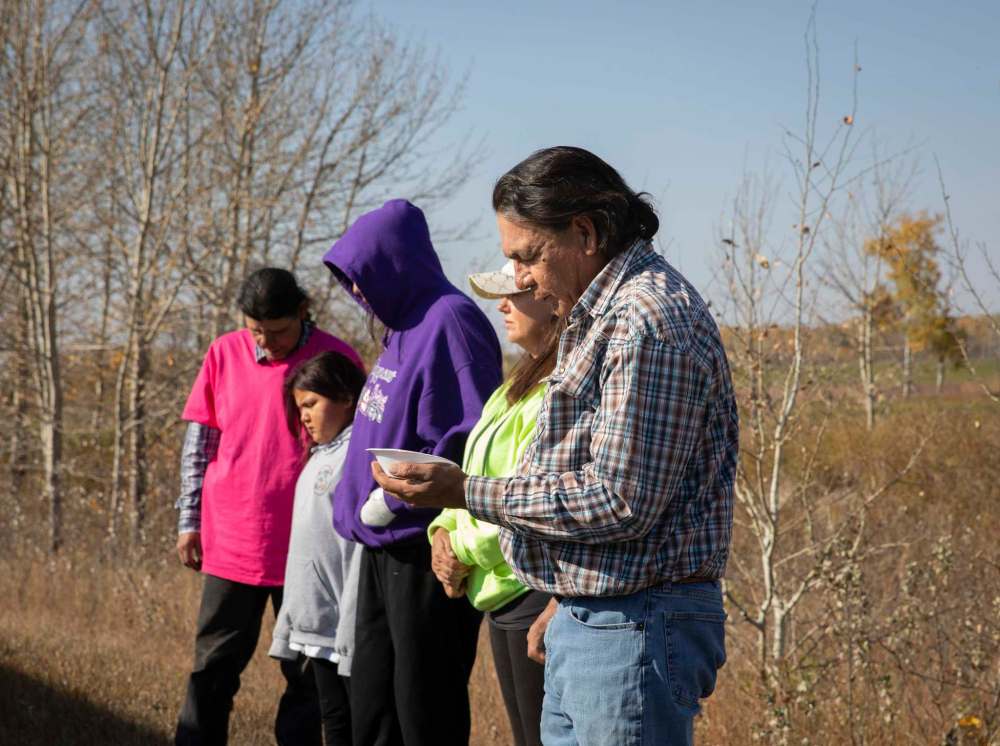
After welcoming the group, Mazawasicuna invites anyone who wishes to share a few words to chime in.
A woman walks to stand beside him, and begins to speak. Her name is Karen, and she comes from nearby Birdtail Sioux Dakota Nation. They are doing this ride in her honour. She’s lost fingers to kidney disease. She gets dialysis three times a week, while she waits for a transplant that may never come.
This is the second consecutive year they have ridden for her, rallying beside her and, now, taking her home.
It has not been an easy road for her family. Her husband, Patrick, who stands beside her, has battled cancer. As she thanks all the riders for being there with her, her voice is so soft that it mingles with the sound of the grasses rustling in the wind. But the breeze is not loud enough to wash away the sound of her crying.
Mazawasicuna’s wife, Helena, goes over to Karen’s side, and gently draws her into an embrace.
“I just want you to know we’re all here for you,” Helena says. “We love you. Just like with everything else, we always stick together.”
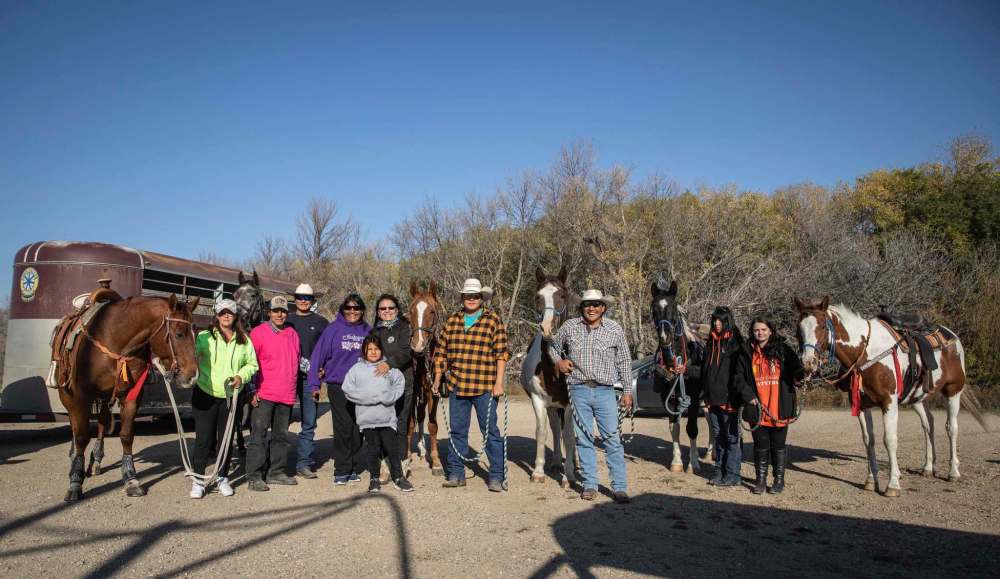
One by one, other people raise their voices. Ann-Marie Tacan speaks about how healing it is just to be near the horses. Her husband Vince Tacan, who was chief of Sioux Valley for 14 years and is now running for the position again, reflects on how Karen’s husband sets a good example for men, of how to support their spouses.
After everyone who wants to speak has had their turn, Mazawasicuna begins to give a prayer before eating.
“We’re grateful to be here,” he begins. “We thank everyone for coming.”
Exactly at this moment, one of the horses, a big, handsome chestnut named Cruz, lifts his nose from his oats and lets out a loud whinny. The riders laugh. Mazawasicuna chuckles as he returns to his prayer.
“The horses too, they’re grateful to be here,” he says. “With the horses here, we honour them too. We treat them good.”
Cruz snorts loudly at this — a happy noise, for a horse — and returns his attention to his oats.
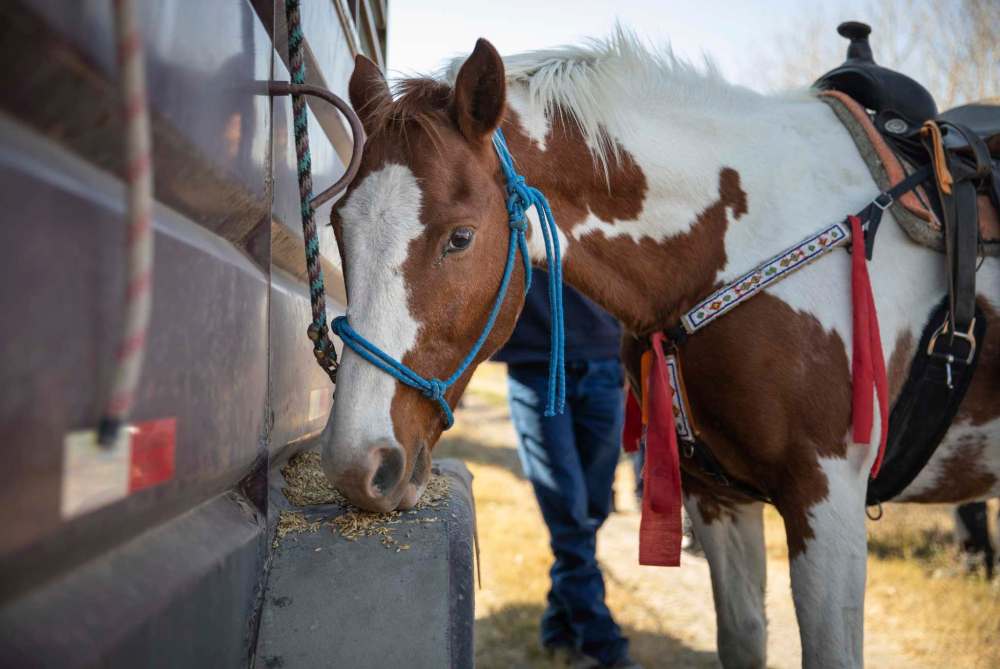
Later, back on the road towards Birdtail, Mazawasicuna thinks back to that moment, and how the horse seemed to respond to what was being said. It doesn’t surprise him. Once, on a ride through four First Nations, they passed the site of the former Birtle residential school, where at least 18 children are known to have died.
Suddenly, the air felt cold, and all the horses started bucking. Even the calmest ones bucked. The riders turned to each other. “Did you feel that?” they asked, and all of them said they did. So they stopped at a nearby community rink and prayed and gave offerings. The horses seemed more settled after that.
“They understand,” Mazawasicuna says.
A history.
Once, many hundreds of years ago, the people of oceti sakowin, the Seven Council Fires, what would later become known as the Sioux Nation, walked across the plains. They walked between villages. They walked to harvest food. They walked following the bison herds that fanned out in numbers so vast they painted the prairies black.
One day a spiritual leader gathered the warriors and asked them to go out and find something to help the oyate, the people. So the warriors set out walking, and when some of them came to the shore of a lake, they discovered a man standing alone at the edge of the water.
They watched as the man reached down and took a handful of sand. When he raised his hand the sand began to form into the shapes of many animals. The man called the warriors over. He had a gift for them, he told them, and then he prayed, and from the sand emerged an animal the warriors had never seen before.
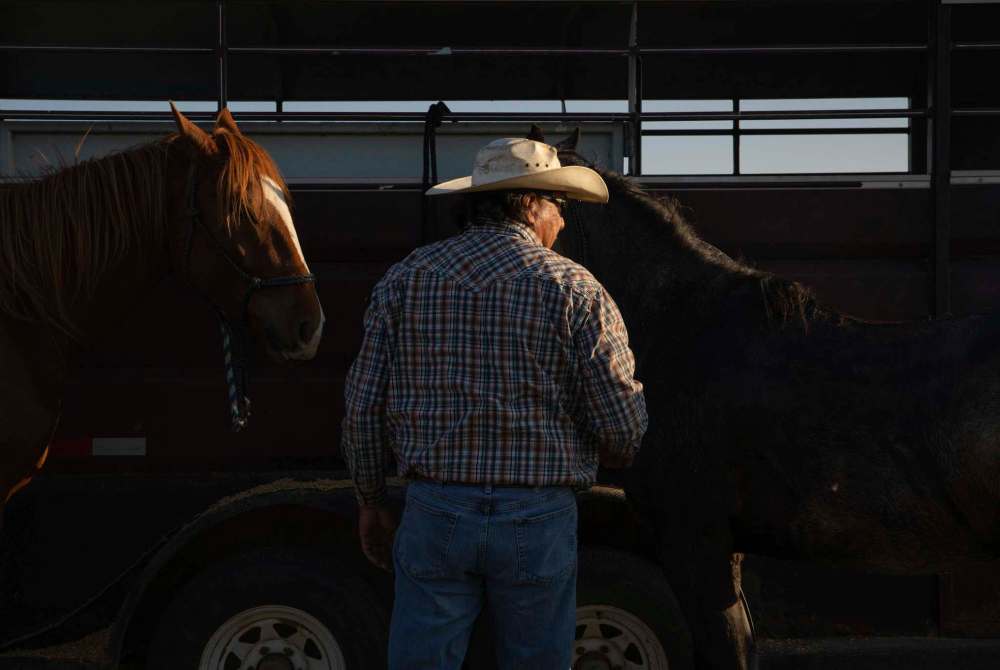
Use these animals, the man said, but never abuse them. If you treat them right, they will always look after you.
When the horses came, the oyate called them sunka wakan, or “sacred dog.” They seemed to understand each other. They formed a union that would transform the oyate’s lives and economies and culture, a union that would spur countless legends and songs, passed from one generation to the next in their own tongue.
This story was given to Travis Mazawasicuna by his grandfather, who received it from his grandfather, and so on.
When Travis was a boy, he dreamed of horses. They came to him at night, and he would go to them in the day. In their free time, he and his brother made simple reins from baling twine, and clambered on the backs of their grandfather’s horses. They rode bareback in blue jeans, shoulders bared to the sun that smiled on Sioux Valley.
“I knew right there, freedom,” he says. “Free. You always felt free. No alcohol or drug could give you that feeling.”
Mazawasicuna’s father was a residential school survivor and suffered in the ways of many survivors, using alcohol to numb the pain. Travis was raised by his grandparents, speaking mostly Dakota: he wasn’t “good at English” until about Grade 5, he says, and most people of his generation can speak their language.

When he was a boy, there was no school in Sioux Valley, so he went to school off the reserve, in places like Kenton and Virden and Brandon. He excelled at sports and made many white friends, but also felt the sting of racism; once, at a junior hockey tryout, he noticed how the other team’s players kept challenging him to fight.
As an adult, Mazawasicuna worked for a while as an addiction counsellor, served as band councillor and, then, as Sioux Valley’s safety officer. To help pay for the more than 20 horses he and his wife tend, including some they rescued and others they received as gifts, he also works at the livestock auction in Virden, organizing cattle by weight.
“Free. You always felt free. No alcohol or drug could give you that feeling.”
— Travis Mazawasicuna on riding horses bareback
The leadership of the Unity Riders came to him through his uncles. They’d launched the first rides in the late 1980s, inspired by a vision of how horses could help unite the Sioux Nation, which spans across the Canada-United States border. The rides, they hoped, would also rally other Indigenous and non-Indigenous communities in harmony.
The first rides traced the routes their ancestors had taken after 1862, when the U.S. government forced the Dakota into exile from their homelands in Minnesota. Along the way, the riders visited Sioux communities on both sides of the border, rejoicing in the chance to speak their language and renew bonds of kinship and culture.

Over time, the inspiration for the rides expanded. They rode to raise awareness of diseases and addictions, and the tragedy of missing and murdered Indigenous women. In 2010, they rode with the Olympic torch as it made its way to Vancouver, and beamed with pride when they watched Wayne Gretzky raise the same flame at the end.
Yet the biggest ride was still to come. In 2013, they organized a ride to the United Nations in New York City, a long trek that took them through Connecticut, where they honoured the victims of the Sandy Hook school shooting, and New York State, where they met up with a delegation of kayakers led by the Haudenosaunee confederacy.
Mazawasicuna was on that ride, following his uncles. In Manhattan, he remembers looking ahead at the long line of horses, cutting through the concrete valleys between looming skyscrapers. From somewhere in the crowd that lined the street, someone called out that they salute the original people of the land.
In that moment, Mazawasicuna felt a weight lift off him, as if all the stings he had felt in the past had been healed.
“That racism (I faced) was just, ‘poof,’” he says. “That burden of all my entire life. It took that long, and that event.”
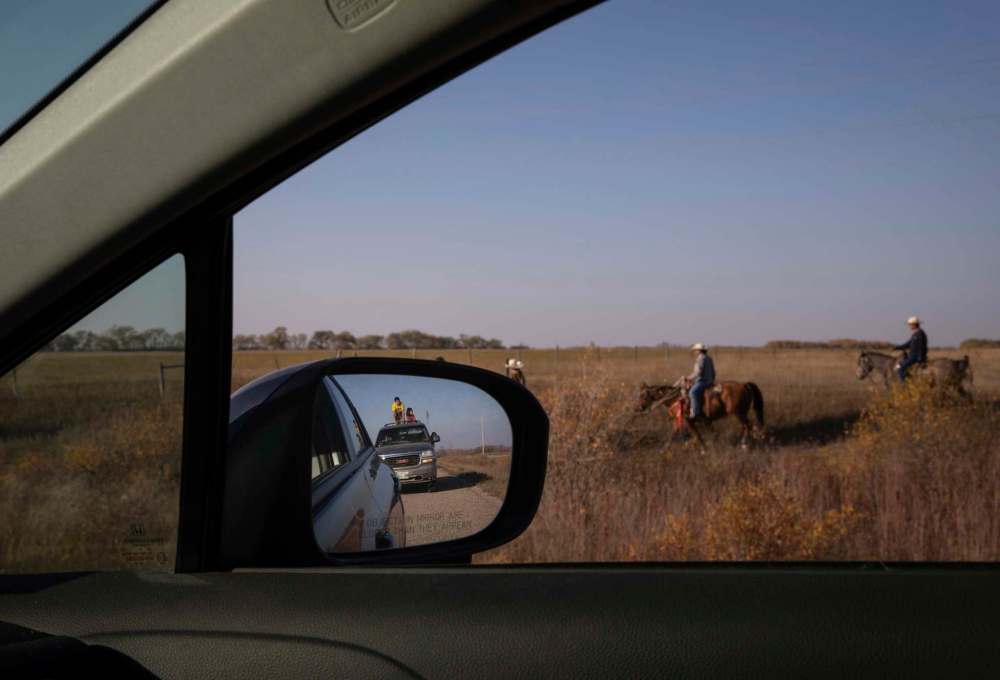
Mazawasicuna met his wife on that ride. Helena was a photographer, who had been invited to take photos of some of the events. She grew up in rural New York; her ancestors came from the Mohican Nation, though due to the particulars of colonial bureaucracy, her family had lost their official registration as American Indians somewhere down the line.
Two years later, they were married. She joined him in Sioux Valley, where they welcomed a son, now six years old. Though Helena had little experience with horses before, she soon became an avid rider. So did her 21-year-old daughter, who has multiple sclerosis and joins the rides when she is visiting from New York.
Not long after that, Mazawasicuna’s uncles were ready to pass the torch, and they asked him to take over the rides. At the time, he was in his 40s, and they wanted “an energetic guy,” he says, who knew horses and loved them. But soon, he felt alone in the work: “I missed all the people who passed on who had horses,” he says.

Still, he found enough meaning in the rides to keep them going. There are times, he says, even that very morning, when it’s hard to get moving, hard to muster the energy to saddle the horses and load the trailers and gather all of the gear they need to make a ride successful.
But this is not just a pastime for him and the other riders. It is also a spiritual journey, a renewal of bonds between horse and people that have sustained a culture for generations. And every time they ride, he watches as people in the vehicles they pass peer out the windows. He sees how their faces brighten, as they wave.
“We see the joy of the elderly people, the children, all the smiles, the happiness, the excitement,” Mazawasicuna says. “Sometimes we see tears of joy. That’s what it’s all about. It’s that dream of those horses saying, ‘We will help the people.’”
Back on the road to Birdtail, Mazawasicuna guides his truck alongside the riders and points out the horses. Each of them has a story. That one is green broke, he says, pointing at a little gelding named Prince with a coat like charcoal viewed through smoke. And that other one, he’s green broke, too, but his training is coming along nicely.
Mazawasicuna’s nephews are astride them, both of them great riders — “naturals” is what Mazawasicuna calls them.
Then there is Billy, who came to them as a gift and once found a little boy who had gone missing; and Rock, who is one of the horses that went to the United Nations. Rock is a particularly spirited horse. Today, Mazawasicuna’s 18-year-old niece Cheyanne is riding him, nudging him to the front of the pack, then breaking into a brisk trot.

She rides beautifully, head high, hands soft, dark hair dancing behind her as the horse dashes off. There’s a story about how she began riding. For years, Mazawasicuna didn’t know his nieces; they’d grown up in foster care. One day in 2013, he spotted a trio of girls coming through his yard, and he asked who their parents were.
“I’m your uncle,” he replied when they told him. “I live right here.”
When he showed the girls the horses, he says, at first they were so frightened they squealed and ran to hide in the truck. But when Cheyanne started to ride, she was a “natural.” Soon she moved in with him and Helena, where she bonded with her horse and blossomed into a regular member of the unity rides.
“She goes through her stuff, the stories she shares about the foster-care system is a story in itself,” Mazawasicuna says, shaking his head. “We try to give her the attention and love, and we try to give her the best for her horse. Her horse keeps her on the right path.”
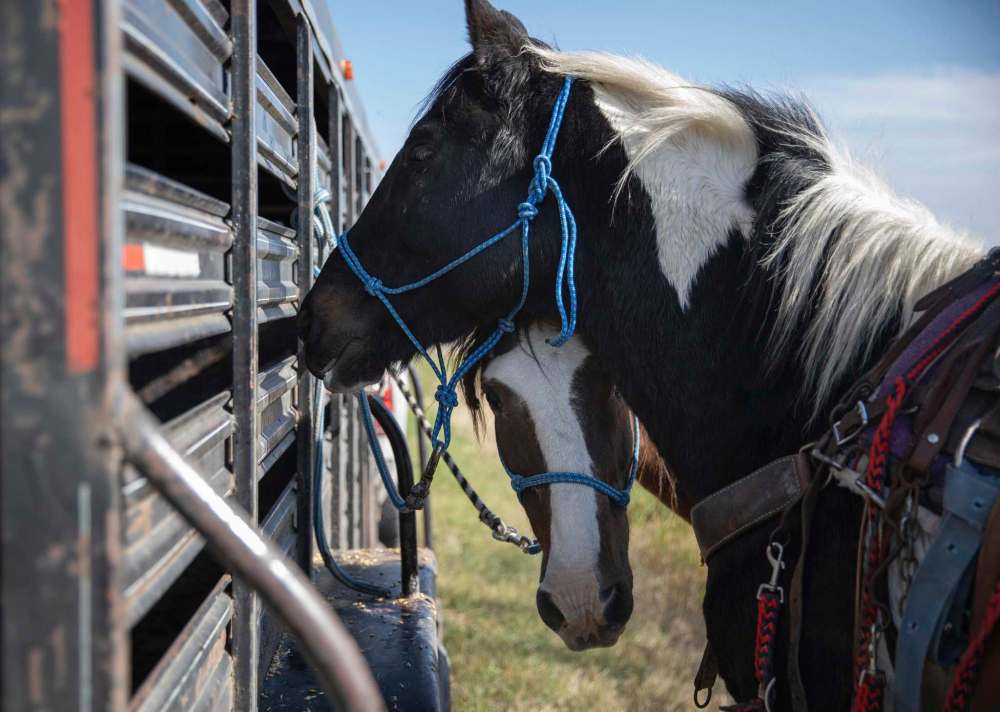
That story, perhaps, underscores another of the reasons they hope to keep the rides going. It’s not just about the causes they bring awareness to, or the continuation of a tradition; it is also about building a healthy future for the next generations of Dakota youth, through a relationship that has been with them for centuries.
That’s something Vince Tacan thinks about a lot. These days, he says, it’s hard to get kids away from their screens and out with the horses. But it’s important, he thinks, in part to heal the wounds colonialism has wrought. It’s about how you need to be with the horses, he says. In teaching them, they teach you about yourself.

You have to be patient to train a horse. You have to earn its trust. You have to control the emotions you let out.
“It’s no secret how residential schools and intergenerational effects have trickled down to everyone, right?” Tacan says. “Even though I didn’t go, I still picked up some behaviours from what I saw growing up. There’s a lot of self-checking you have to do all the time, because at the end of the day you’re trying to break cycles.
“If it takes working with horses to break that cycle, then that’s what you gotta do to get kids interested, and get them aware with themselves,” he continues. “You’ll never train a horse if you’re not in touch with yourself…. So for us, it’s a spiritual thing. The connection goes way back. It’s those things we take our teachings from.”

It’s true people in Sioux Valley don’t use horses as often as their ancestors did. Nobody does, after all, because technology long since replaced the horse as a necessary means of work or transportation. But here, maintaining the relationship is not only about pleasure or practicality. It is also about carrying the pride of a nation.
Once, after a visit to Sioux Valley, one of Mazawasicuna’s Ojibwe friends teased him a little about that legacy.
“You know what, Travis?” the man said. “The Sioux people used to be the best horsemen around, you see it in all the books. Well, I came to your community and I see a lot of horses standing around in pastures. So you know what? Not anymore. We’re the best horsemen now.’”
Mazawasicuna chuckles at the memory. “I started laughing,” he says. “But it motivated me to do more.”
When the riders reach the edge of Birdtail Sioux Dakota Nation, they pull the horses to a halt. From inside the van following the ride, Karen, the woman who is waiting for a kidney transplant, steps out. Helena pulls Cruz, the calmest horse, up beside her and steadies it while the riders help Karen climb astride.
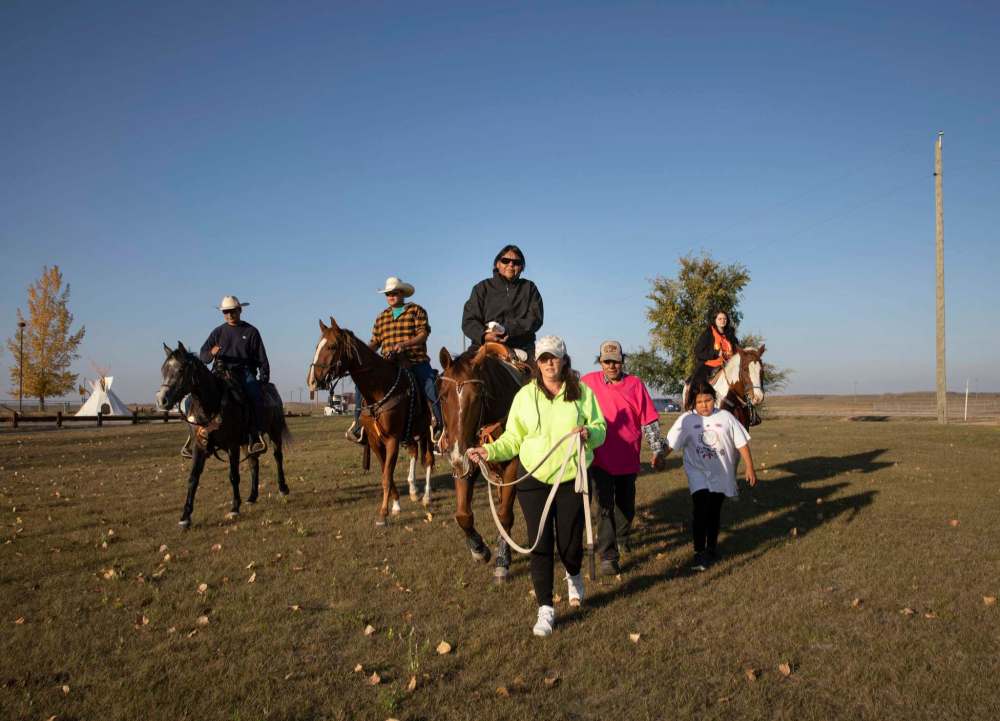
Step by step, Helena leads the horse forward, walking Karen home on horseback, a position of honour. As her body gently sways with the animal’s gait, she sits up proud. Her husband and granddaughter walk beside her. A slight smile spreads on her face as the horse makes the last steps of the journey.
“Did you see her expression?” Mazawasicuna says after the riders help Karen dismount. “She’d wanted to do that a long time.”
Here, at the end of a journey, there is a small feast set up on a picnic table. There are more oats for the horses and bannock for the people. For a while they sit and mingle with Karen and her family, laughing softly in the gentle air of early evening.
In front of a small teepee set up near the picnic tables, Tacan stands, and begins to speak. He thanks Karen and her husband for allowing the riders to be with them. He thanks the riders, and he speaks about what it means to ride, about what it means to make the journey between these Dakota communities.

“I feel strongly about staying connected to our culture, to our horses, to each other, to family, and supporting each other through difficult events,” he says. “That’s kind of the thing that our people are known for… really glad to see that we’ve come together as relatives and spent the whole day together.”
Then he offers a prayer in Dakota, opening with the name of wakan tanka, the divine, the great mystery.
The sun is growing heavy now, sinking behind the teepee poles that reach to the blue October sky. There is no word for “goodbye” in Dakota, Mazawasicuna says. Look it up in a Dakota-English dictionary, you’ll find no matches. Look up any similar word, such as “farewell.” You’ll find no matches. Yet there are words to say in parting.
“Toksa akhe,” Mazawasicuna says, slowly at first, to let the visitors try to catch the sound of it on their tongues.
See you again.
melissa.martin@freepress.mb.ca

Melissa Martin
Reporter-at-large
Melissa Martin reports and opines for the Winnipeg Free Press.

Jessica Lee
Photojournalist
After freelancing from abroad and in Toronto for most of her career, Jessica Lee moved to Winnipeg from Toronto in 2021 to join the Free Press.
Our newsroom depends on a growing audience of readers to power our journalism. If you are not a paid reader, please consider becoming a subscriber.
Our newsroom depends on its audience of readers to power our journalism. Thank you for your support.






